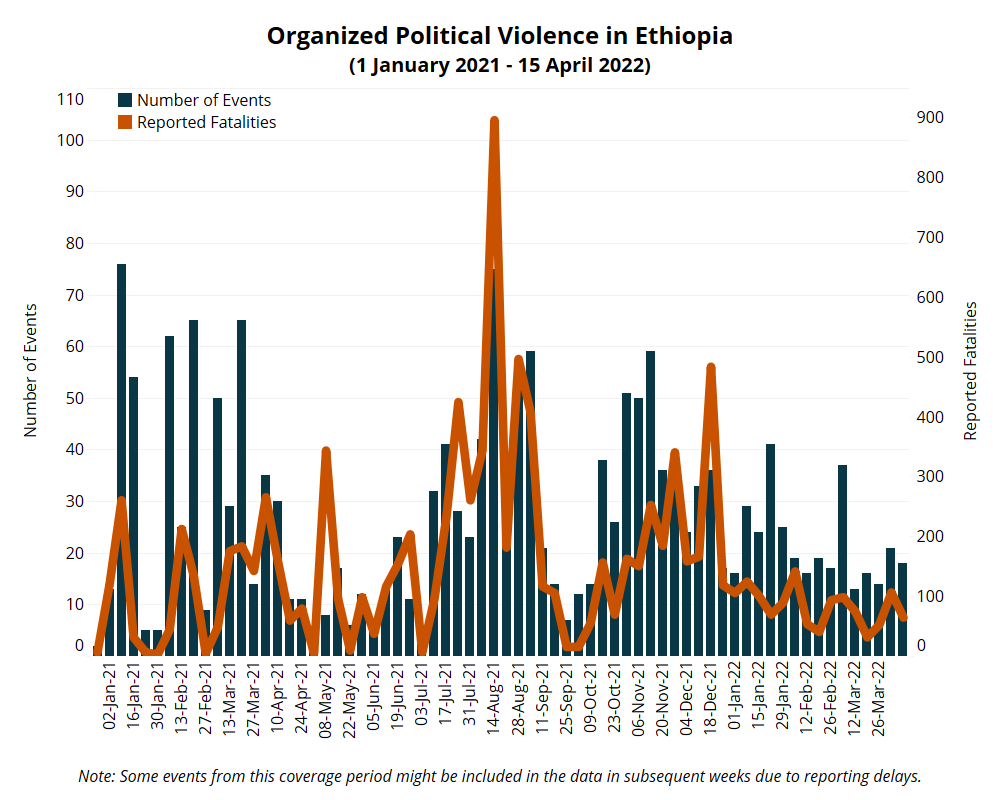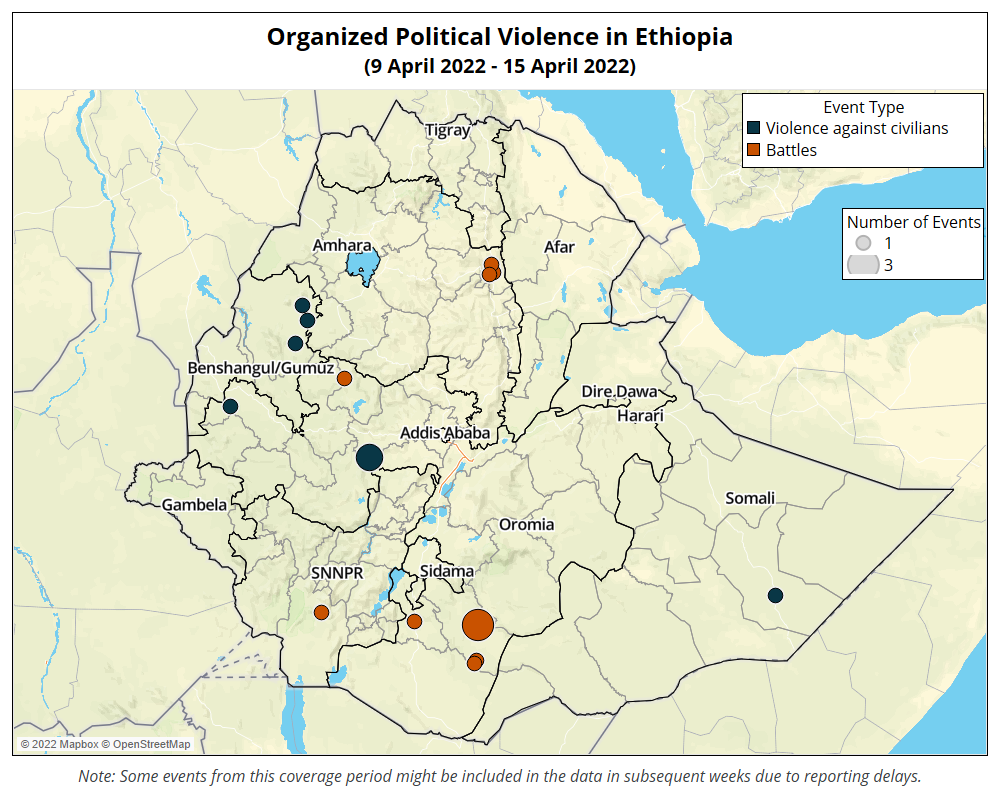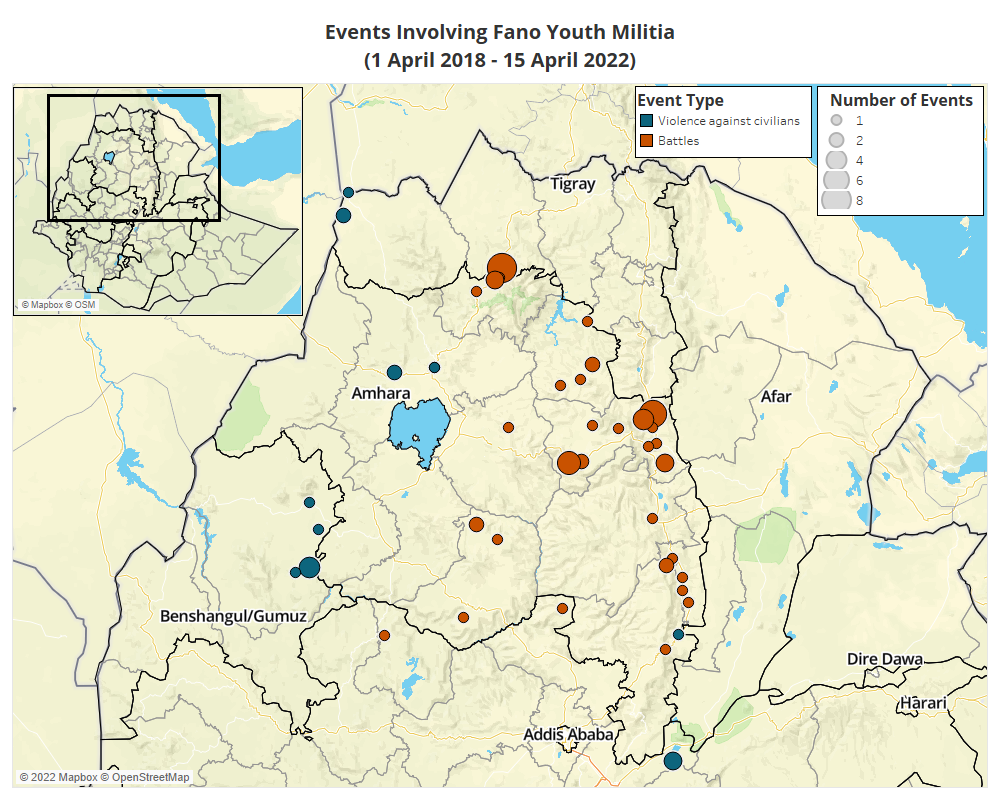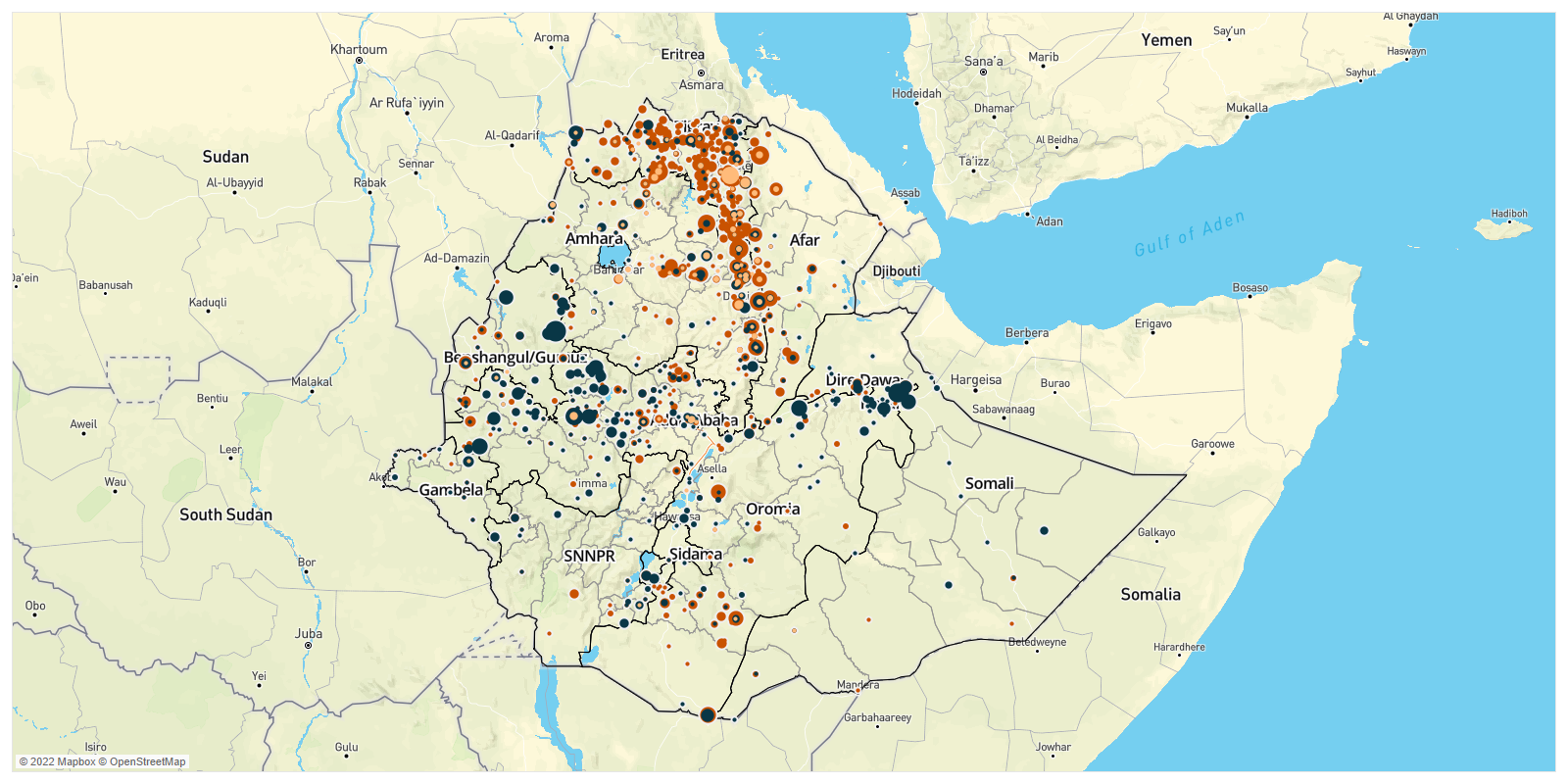By the Numbers: Ethiopia, 2 April 2018-15 April 2022 1Figures reflect violent events reported since Prime Minister Abiy Ahmed came to power on 2 April 2018.
- Total number of organized violence events: 2,850
- Total number of reported fatalities from organized violence: 15,686
- Total number of reported fatalities from civilian targeting: 7,147
By the Numbers: Ethiopia, 9-15 April 2022 2Some events from this coverage period might be included in the data in subsequent weeks due to reporting delays.
- Total number of organized violence events: 18
- Total number of reported fatalities from organized violence: 65
- Total number of reported fatalities from civilian targeting: 20
Ethiopia data are available through a curated EPO data file as well as the main ACLED export tool.

Situation Summary
Last week, government forces and the Oromo Liberation Front (OLF)-Shane continued to clash in Oromia region. ACLED recorded six-armed clash events between the two sides, with five occurring in Guji zone. From 9 to 11 April, the Ethiopian National Defense Force (ENDF) and OLF-Shane clashed in Darara in Gora Dola woreda in Guji zone. The OLF-Shane claimed to have killed 31 soldiers and injured 33 others during these clashes (OMN, 11 April 2022; OMN, 14 April 2022). This claim, however, could not be independently confirmed. On 10 April, ENDF and Oromia regional special forces clashed with the OLF-Shane in Melka Guba, Malka Lammi, and Malka Kule in Gumi Idalo woreda in Guji zone, resulting in an unidentified number of fatalities. On the same day, the OLF-Shane and ENDF clashed in Kedida village in Bule Hora town in West Guji zone.
Attacks against civilians also continued in the region. On 10 and 12 April, Amhara ethnic militias opened fire on civilians and burnt homes of farmers in Ali Abo Sare and Hulegeta Karrayyu in Nono woreda in West Shewa zone. An unidentified number of fatalities were reported in the Hulegeta Karrayyu attack while casualties in Ali Abo Sare are unknown. The militiamen claimed to have carried out the attack in Ali Abo Sare “in retaliation against the OLF-Shane’s previous attacks on Amharas” (BBC Afaan Oromoo, 14 April 2022). Moreover, last week, members of the ENDF shot and killed three civilians in Boji in Gudetu Kondole woreda in West Wollega zone after accusing them of supporting the OLF-Shane. ENDF and Oromia regional special forces arrested over 300 civilians on suspicion of supporting the OLF-Shane in Boji.
ACLED recorded several events involving Fano militias in Oromia and Amhara regions. In Oromia region, Fano militias clashed with federal police forces in Cidhati kebele in Amuru woreda in Horo Guduru Wollega zone, resulting in the deaths of an unknown number of soldiers. The reason behind the clashes is unknown. In Amhara region, on 10 April, members of the ENDF and Fano militias exchanged fire in Woldiya town in North Wello zone when Fano militiamen from surrounding areas tried to enter the town following rumors that a Fano militia leader was arrested. A militia member and a priest were killed due to the clashes. On the same day, the two groups also fought in Gobeye and Robit in North Wello zone. There were no reported casualties in these areas. The head of the North Wello zone communication office indicated that the conflict has been resolved through dialogue (BBC Amharic, 11 April 2022).
In Benshangul/Gumuz region, from 10 to 12 April, the ENDF, Amhara ethnic militias, and Amhara regional special forces killed an unknown number of ethnic Gumuz civilians in Godorare village in Bulen woreda, Dilsambe and Mender 3 in Dangura woreda, and Oshingi and Yekita villages in Madira woreda in Metekel zone (see map below). Meanwhile, according to the Dangur woreda command post, 247 members of the Gumuz People’s Democratic Movement (GPDM) have peacefully surrendered to government security forces (Ethiopian Broadcasting Corporation, 15 April 2022). Additionally, on 9 April, a traditional peace and reconciliation ceremony was held between elders, religious leaders, government officials, and members of the GPDM who were undergoing reintegration training in Gilgel Beles town in Metekel zone (Fana Broadcasting Corporate, 9 April 2022). A similar traditional peace and reconciliation ceremony was held between the regional government and leaders of the GPDM – political and armed wings – in Kamashi zone on 19 March (see EPO Weekly: 12-18 March 2022 for more on Kamashi traditional peace and reconciliation ceremony).

Demonstrations at the administration center of the Southern Nations, Nationalities and Peoples region (SNNPR), which is located in Hawasa city in Sidama region, continued last week. On 13 April, members of the Koore ethnic group gathered in front of the SNNPR regional president’s office in Hawasa city and peacefully demanded that the government stop “atrocities against Koore farmers in Amaro woreda by OLF-Shane rebels” (VOA Amharic, 13 April 2022). Two days later, Sebatbet Dobi Kistane ethnic group members from Gurage zone held a peaceful protest in Hawasa city, demanding the establishment of a separate woreda for their ethnic group to self-govern. A week earlier, on 7 April, Mareko ethnic group members from Gurage zone held a peaceful demonstration in front of the SNNPR president’s office in Hawasa city to demand that Mareko woreda be recognized as a special woreda, separated from Gurage zone.
Last week, two attacks were reported by armed actors from neighboring countries. Around 13 April, ethnic Turkana militias from Kenya reportedly crossed the border into Ethiopia and shot and killed a government officer (The Standard, 13 April 2022). The exact location of this incident is unknown. On 14 April, Marehan clan militia from neighboring Somalia attacked civilian pastoralists from Maqabul-Muse Gumcadle sub-clan group and killed five people near Caleen town in Korahe zone in Somali region. Previously, on 2 March, Marehan and Maqabul-Ismail Gumcadle militias clashed near Lehelow Yucub village in Doolo zone due to a land dispute.
On 15 April, 50 trucks carrying humanitarian aid arrived in Mekele city in Tigray region (WFP Ethiopia, 15 April 2022; FDRE Government Communication Service, 14 April 2022). The number of internally displaced people (IDPs) entering Sekota town in Wag Hemra zone in Amhara region from areas controlled by the Tigray People’s Liberation Front (TPLF) has increased in recent weeks. The town currently hosts more than 70,000 IDPs from Abergele, Tsagebji, Zabta, Korem, and Zeqwala woredas (VOA Amharic, 12 April 2022). The humanitarian need in Afar region is also dire (UNOCHA, 14 April 2022). In the meantime, on 13 April, the TPLF stated that its forces have evacuated from Erebti area in Afar region (BBC Amharic, 13 April 2022). However, this claim could not be independently confirmed. Since 30 March, there have been no reported armed clashes between the TPLF and Afar regional special forces and affiliates in Kilbati Rasu-Zone 2 in Afar region.
Weekly Focus: Fano Militias and Continued Tension Between Amhara and Oromia Regions
Irregular Fano militias, armed and trained as a defensive force against the TPLF, have become a point of increasing tension among political actors in Ethiopia. Clashes between Fano militias and forces from the Amhara regional government, as well as ongoing fighting involving Fano militias in Oromia region and Oromo special zone of Amhara region highlight the dangerous nature of the political issues surrounding these militias (see map below).

In Amhara region, Fano militias are viewed as a security force that exists to protect ethnic Amhara people, advance Amhara interests, and preserve a unified Ethiopian state. The term itself is difficult to define – ‘Fano’ can refer to many different types of irregular security forces and its meaning has changed over time. Traditionally, ‘Fano’ referred to armed local community protection security units that existed in rural Amhara communities. In the 2014-2018 period, the term ‘Fano’ became synonymous with unarmed youth demonstrators who resisted the rule of the Ethiopian People’s Revolutionary Democratic Front (EPRDF)-led TPLF government. Throughout that period, Fano youths pushed for agendas regarding the administration of lands historically claimed by ethnic Amharas, channelling these demands through the Wolkait Identity Question Committee under Colonel Demeke Zewdu. Demeke Zewdu is often viewed as the leader of Amhara Fano today. Demeke Zewdu was appointed head of security for Western Tigray zone — referred to by Amhara ethno-nationalists as Wolkait Tegede Humera zone/region – by Amhara region shortly after the start of Ethiopia’s northern conflict.
Fano militias became especially important when the TPLF attacked Amhara region through the A2 (Addis Ababa-Axum) and B30 (Gondar-Adawa) highways, playing an important role as armed resistance while the Ethiopian army was regrouping. During this time, important figures linked to the Fano also came into conflict with the Ethiopian government, accusing it of retreating and betraying the Amhara people.
To many ethnic Amharas, Fano militias are heroes that have liberated and protected the long-oppressed people of Amhara, a sacrifice worthy of recognition. To others in Ethiopia, the Fano represent a semi-organized group of armed youths that are engaged in territorial “land grabbing,” backed by Amhara ethno-nationalist organizations. In their latest joint report, Amnesty International and Human Rights Watch accused Fano militias of being involved in abuses against ethnic Tigrayans, including executing around 60 people in an area near Adi Goshu (Amnesty International, 5 April 2022). On 4 April 2022, the Oromia regional government alleged that Fano militias — referred to as “extremist forces from Amhara region” – were responsible for the deaths of 26 Oromia regional security forces and federal police in East Shewa zone in Oromia region (Addis Standard, 4 April 2022; see EPO Weekly: 26 March-1 April 2022 for more information on clashes at the border of North Shewa zone in Amhara region and East Shewa zone in Oromia region). Conflicts involving Fano militias include hostilities in Western Tigray zone of Tigray region, East Shewa zone of Oromia region, Metekel zone of Benshangul/Gumuz region, East Wollega zone of Oromia region, and Oromia special zone of Amhara region. Recently, conflict within Amhara region involving Fano militias and government forces has also emerged.
The debate surrounding proposals to disarm Fano militias is hotly contested. The Fano enjoys large amounts of community support in Amhara region and are credited with saving the region from the TPLF. Political actors in Amhara region, including those from the Amhara regional government, have stated that they would not disarm the Fano militias, but rather would “organize” them (Addis Standard, 17 January 2022). Despite this statement, efforts by the Amhara regional government to arrest or restrict Fano leaders over the past few weeks have led to fatal clashes between Amhara regional special forces and federal police and Fano militias in North Wello and East Gojam zones.
The participation of Fano militias in conflicts throughout Ethiopia is highly contentious and has exacerbated tensions between regional states. ACLED recorded at least four clashes and violence against civilians events involving Fano militias in Oromia region over the past year. The latest incident involves Fano militias that were accused of attacking ethnic Oromo civilians in Oromia special zone of Amhara region, an area that is frequently the scene of inter-ethnic fighting (Addis Standard, 19 April 2022). Like identifying OLF-Shane forces involved in territorial conflicts, identifying Fano militias in contested areas is difficult given that they do not wear uniforms and are only unofficially organized.
As tensions between the regional governments continue to build, Fano militias from Amhara region are likely to become an increasingly salient point of debate for political actors. The trajectory of Amhara region’s influence beyond its current boundaries, and its place within Ethiopia, is dependent on decisions made about the informal Fano militias.






